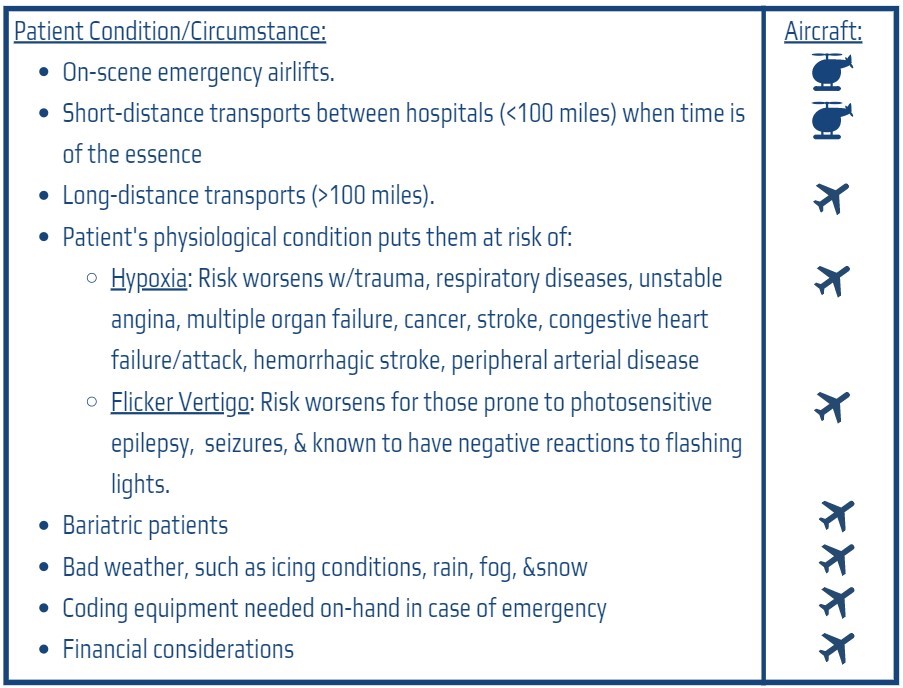Both helicopters and fixed-wing airplanes offer air ambulance services for transporting patients. However, different circumstances require specific aircraft:
When to use a Helicopter:
- On-scene emergency airlifts, such as the site of a car accident. Helicopters can take off and land just about anywhere.
- Short-distance transports between hospitals. If a stable patient needs to be moved a short distance (less than 100 miles) and their condition would not be negatively affected by increases in altitude, a helicopter may be the most-convenient option.
In conclusion, helicopters are used for short-distance, trauma-related emergency situations where time is crucially important.
When to use a Fixed-Wing:
- Long-distance (100 miles or more) transportations of stable patients. Fixed-wing aircraft can handle longer flights better than helicopters can.
- When a patient is at risk of adverse effects from flying in a helicopter. These include:
- Even below 10,000 feet elevation a patient’s physiological condition can require them to be transported in a pressurized aircraft. Most helicopters do not have this capability. Such conditions include:
- Trauma, respiratory diseases, unstable angina, multiple organ failure, cancer, stroke, congestive heart failure, heart attack, hemorrhagic stroke, peripheral arterial disease.
- Flicker Vertigo. Flicker vertigo is caused by exposure to flickering or flashing lights that cause nausea, dizziness, headaches, panic, confusion, and in some cases seizures and blacking out. In a helicopter, sun or light passing through or reflecting off the rotor blades can cause a flickering effect in the cabin.
- Patients with photosensitive epilepsy or otherwise known to have negative reactions to flashing lights should avoid helicopter transport.
- Bariatric patients. Both helicopters and fixed-wing aircraft take weight into account regarding all passengers, including pilots and medical staff. Due to their compact operating size, helicopters are very weight limited.
- Inability to work code in a helicopter. Most medical equipment is stored in a compartment on the outside of a helicopter to save space. If emergency action is needed, the helicopter would need to land for the medical crew to access necessary equipment. This situation frequently creates a “hot landing,” in which rotor blades continue to spin, and exposes the patient to downdrafts, noise, and even dust and debris.
- During bad weather. This includes
- Icing Conditions: Helicopters don’t have anti-icing equipment like fixed-wings do, such as heating the edge of the wing or inflating pneumatic boots. Icing is a cause for concern after liftoff too. The temperature decreases as the aircraft gains altitude, increasing the risk of icing—especially when humidity is high.
- Rain, Fog, and Snow: Lacking IVF equipment (electronic equipment that allows pilots to gauge conditions even when their window-vision is obscured), helicopters have trouble landing in these conditions. Fixed-wing aircraft always include an IVF system, though they too will take extra caution during takeoff and landing due to slippery conditions.
- Financial Considerations. It cost significantly less to fly a fixed-wing aircraft than a helicopter, especially when it comes to medical flights.
- Even below 10,000 feet elevation a patient’s physiological condition can require them to be transported in a pressurized aircraft. Most helicopters do not have this capability. Such conditions include:
CSI Aviation always takes note of a patient’s condition before accepting a transport. Should a helicopter flight be the swiftest and most necessary form of action, we will not hesitate to recommend it. For situations where a fixed-wing aircraft is mandatory, we offer our exceptional services. Every flight includes both a critically care trained paramedic, nurse, and two pilots.




